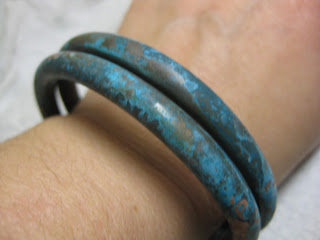 |
| Copper Bracelet by GeltDesigns |
The discovery of the pipe stash led to a number of jewelry ideas-- some simple, some less so. Today we present a very simple bangle bracelet made from copper pipes.
Tools
Jewelers saw and saw blades
Bench pin and anvil
Half-round file
220-grit wet/dry sandpaper
400-grit
Oval bracelet mandrel
Renaissance Micro-Crystalline Wax Polish
Step 1
Measure your wrist or the wrist of the person for whom you are making the bracelet. Use your measurement to determine how much copper pipe you will need to make your bracelet. See out tutorial How to Determine Bracelet Sizes if you need help calculating how much material you will need. For our bracelet, we used 18-inches of copper pipe.
Step 2
Cut the pipe. Steady the pipe on a bench pin and anvil and use your jewelers saw and saw blades
Step 3
File the ends of the cut pipe with a half-round file to remove tool marks caused when sawing the pipe.
Step 4
Sand the ends using 220-grit wet/dry sandpaper to remove tool marks caused when filing the pipe ends. Switch to 400-grit
Step 5
Bend the copper tubing around the oval bracelet mandrel.
Note: If you are having trouble bending the copper tube, then it may be work hardened. If the copper pipe is difficult to bend, anneal the pipe with your torch to soften the metal and make it easier to form. Pickle the copper pipe to remove oxidation formed when annealing the copper pipe.
Step 6
Add color to the bracelet. Wet some paper towels with ammonia so the towels are damp but not soaking wet. Place the bracelet in the ammonia soaked paper towels and place into a sealed jar. Allow the ammonia to patina the copper overnight. There will likely be some blue on the paper towels.
Step 7
Coat the bracelet with Renaissance Wax
Related Tutorials
How to Determine Bracelet Sizes
How to Use a Jewelry Saw
How to Use a File for Jewelry Making
How to Use Sand Paper
How to Create a Blue Patina on Copper
All about Patina
How to Anneal Metal for Jewelry Making
How to Make Pickle
How Use Renaissance Wax
GeltDesigns Tutorials by Topics
Further Reading
Contemporary Copper Jewelry: Step-by-Step Techniques and Projects
Mixed Metals: Creating Contemporary Jewelry with Silver, Gold, Copper, Brass, and More
Copper Art Jewelry: A Different Luster
Complete Metalsmith: Professional Edition
Day 11. Week 2. Jewelry from Found Objects. $ spent: 0
Found materials: copper pipe (for ice maker and refrigerator)
New Jewelry a Day.


